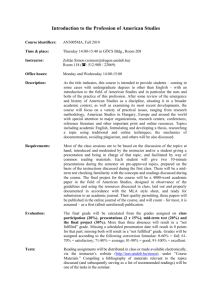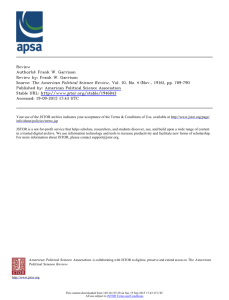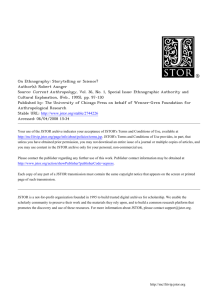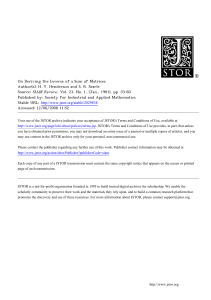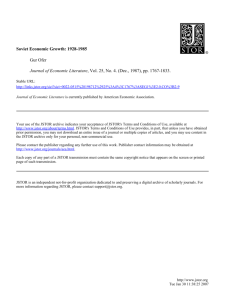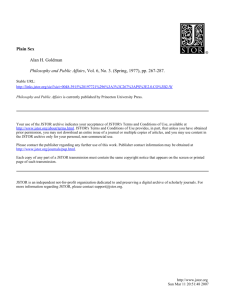Social Conflict and the Theory of Social Change
advertisement
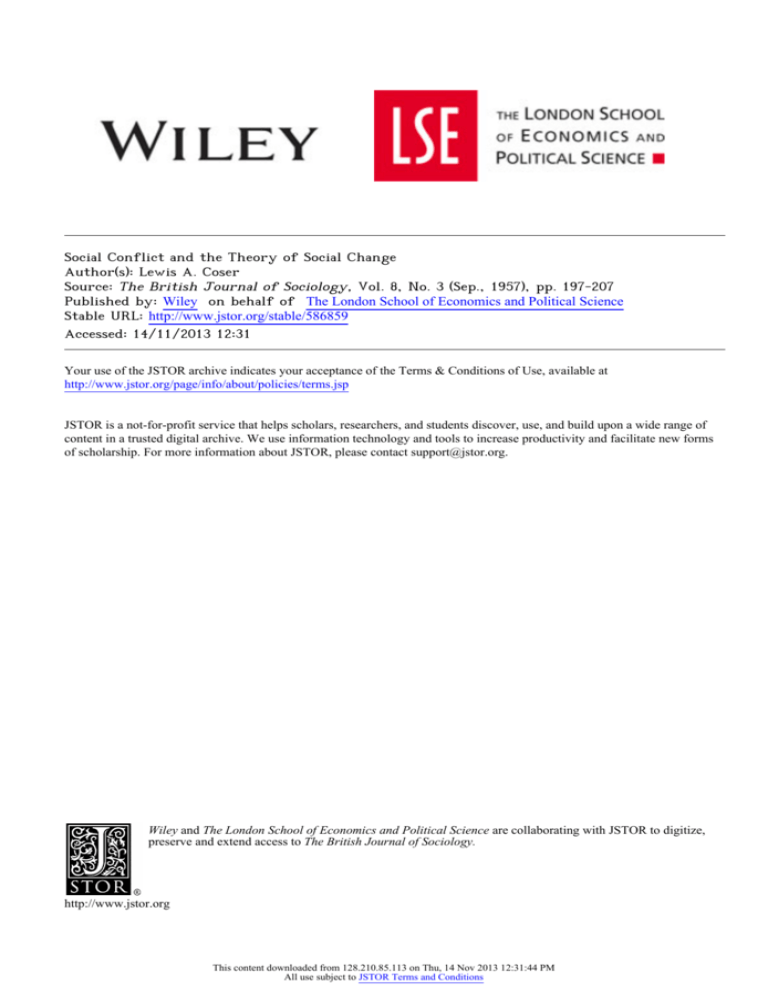
Social Conflict and the Theory of Social Change
Author(s): Lewis A. Coser
Source: The British Journal of Sociology, Vol. 8, No. 3 (Sep., 1957), pp. 197-207
Published by: Wiley on behalf of The London School of Economics and Political Science
Stable URL: http://www.jstor.org/stable/586859 .
Accessed: 14/11/2013 12:31
Your use of the JSTOR archive indicates your acceptance of the Terms & Conditions of Use, available at .
http://www.jstor.org/page/info/about/policies/terms.jsp
.
JSTOR is a not-for-profit service that helps scholars, researchers, and students discover, use, and build upon a wide range of
content in a trusted digital archive. We use information technology and tools to increase productivity and facilitate new forms
of scholarship. For more information about JSTOR, please contact support@jstor.org.
.
Wiley and The London School of Economics and Political Science are collaborating with JSTOR to digitize,
preserve and extend access to The British Journal of Sociology.
http://www.jstor.org
This content downloaded from 128.210.85.113 on Thu, 14 Nov 2013 12:31:44 PM
All use subject to JSTOR Terms and Conditions
SOCIAL CONFLICTAND THE THEORY
OF SOCIAL CHANGE
LewisA. Coser
NHIS paperattemptsto examinesomeof the functionsof social
conflictin the processof social change. I shallfirst deal with
i
somefunctionsof conflictwithinsocialsystems,morespecifically
with its relationto institutionalrigidities,technicalprogressand productivity,and will then concernourselveswith the relationbetween
socialconflictand the changesof socialsystems.
onViolence
which
A centralobservationof GeorgeSorelin hisReflections
has not as yet been accordedsufficientattentionby sociologistsmay
serveus as a convenientspringboard.Sorelwrote:
r
We are todayfacedwith a new and unforeseenfact a middleclasswhich
seeksto weakenits own strength.The race of bold captainswho made the
greatnessof modernindustrydisappearsto make way for an ultracivilized
aristocracywhich asksto be allowed to live in peace.
The threateningdecadencemay be avoidedif the proletariathold on with
obstinacyto revolutionaryideas. The antagonisticclassesinfluenceeachotherin a
partlyindirectbutdecisivemanner.Everythingmay be savedif the proletariat,by
their use of violence, restore to the middle class somethingof its former
energy.l
Sorel'sspecificdoctrineof classstruggleis not of immediateconcern
here.Whatis importantforus is the idea thatconflict(whichSorelcalls
violence,usingthe wordin a veryspecialsense)preventsthe ossification
of the socialsystemby exertingpressurefor innovationand creativity.
ThoughSorel'scall to actionwas addressedto the workingclassand its
interests,he conceivedit to be of generalimportancefor the totalsocial
system;to his mind the gradualdisappearanceof class conflictmight
well lead to the decadenceof Europeanculture.A social system,he
felt, was in need of conflictif only to renewits energiesand revitalize
its creativeforces.
This conceptionseemsto be moregenerallyapplicablethan to class
strugglealone. Conflictwithin and between groupsin a society can
prevent accommodationsand habitual relations from progressively
impoverishingcreativity.The clashof valuesand interests,the tension
betweenwilat is and what some groupsfeel ought to be, the conflict
I 97
This content downloaded from 128.210.85.113 on Thu, 14 Nov 2013 12:31:44 PM
All use subject to JSTOR Terms and Conditions
LEWIS A. COSER
betweenvested interestsand new strataand groupsdemandingtheir
share of power, wealth and status,have been productiveof vitality;
note for examplethe contrastbetweenthe 'frozenworld'of the Middle
Ages and the burstof creativitythat accompaniedthe thaw that set in
with Renaissancecivilization.
This is, in effect, the applicationof John Dewey's theory of consciousnessand thoughtas arisingin the wakeof obstaclesto the interactionof groups.'Conflictis the gadflyof thought.It stirsus to observation and memory.It instigatesto invention.It shocksus out of sheeplike passivity,and sets us at noting and contriving.... Conflictis a
sznequanonof reflectionand ingenuity.'2
Conflictnot only generatesnew norms,new institutions,as I have
pointedout elsewhere,3it may be said to be stimulatingdirectlyin the
economic and technologicalrealm. Economichistoriansoften have
pointedout that much technologicalimprovementhas resultedfrom
the conflictactivityof tradeunionsthroughthe raisingof wage levels.
A risein wagesusuallyhasled to a substitutionof capitalinvestmentfor
labourand henceto an increasein the volumeof investment.Thus the
extreme s-<echanization
of coal-miningin the United Stateshas been
partlyexplainedby the existenceof militantunionismin the American
coalfields.4>
A recent investigationby Sidney C. Sufrin5points to the
effectsof unionpressure,'goadingmanagementinto technicalimprovement and increasedcapitalinvestment'.Very muchthe samepointwas
made recentlyby the conservativeBritishEconomistwhich reproached
Britishunionsfor their 'moderation'whichit declaredin part responsible for the stagnationand low productivityof Britishcapitalism;it
comparedtheir policy unfavourablywith the more aggressivepolicies
of Americanunionswhoseconstantpressurefor higherwageshas kept
the Americaneconomydynamic.6
This point raisesthe questionof the adequacyand relevancyof the
'human relations'approachin industrialresearchand management
practice.The 'humanrelations'approachstressesthe 'collectivepurpose
of the totalorganization'of the factory,and eitherdeniesor attemptsto
reduceconflictsof interestsin industry.7But a successfulreductionof
industrialconflictmay have unanticipateddysfunciionalconsequences
for it may destroyan importantstimulusfor technologicalinnovation.
It often has been observedthat the effectsof technologicalchange
haveweighedmostheavilyuponthe worker.8 Bothinformalandformal
organizationof workersrepresentin part an attemptto mitigatethe
insecuritiesattendantuponthe impactof unpredictableintroductionof
change in the factory.9But by organizingin unions workersgain a
feeling of securitythrough the effectiveconduct of institutionalized
conflictwith managementand thus exert pressureon managementto
increasetheirreturnsby the inventionof furthercost-reducingdevices.
The searchfor mutualadjustment,understandingand 'unity'between
I98
This content downloaded from 128.210.85.113 on Thu, 14 Nov 2013 12:31:44 PM
All use subject to JSTOR Terms and Conditions
SOCIAL CONFLI CT AND SOCIAL CHANGE
groupswho find themselvesin differentlifesituationsandhavedifferent
life chancescallsforththe dangerthat Sorelwarnsof, namelythat the
furtherdevelopmentof technologywould be seriouslyimpaired.
The emergenceof inventionand of technologicalchangein modern
Westernsociety,with its institutionalization
of scienceas an instrument
for making and remakingthe world, was made possible with the
gradualemergenceof a pluralisticand henceconflict-charged
structure
of humanrelations.In the unitaryorderof the medievalguild system,
'no one was permittedto harmothersby methodswhich enabledhim
to producemorequicklyand morecheaplythan they. Technicalprogresstook on the appearanceof disloyalty.The ideal was stable conditionsin a stableindustry.'10
In the modernWesternworld,just as in the medievalworld,vested
interestsexertpressurefor the maintenanceof establishedroutines;yet
the modernWesterninstitutionalstructureallowsroomfor freedomof
conflict.The structureno longerbeing unitary,vestedinterestsfind it
difficultto resistthe continuousstreamof change-producing
inventions.
Invention,as well as its applicationand utilization,is furtheredthrough
the ever-renewedchallengeto vested interests,as well as by the conflictsbetweenthe vestedintereststhemselves.1l
Onceold formsof traditionalandunitaryintegrationbrokedown,the
clashof conflictinginterestsandvalues,nowno longerconstrainedbythe
rigidityof the medievalstructure,pressedfor new formsof unification
and integration.Thus deliberatecontroland rationalizedregulationof
'spontaneous'processeswasrequiredin militaryand political,as well as
in economicinstitutions.Bureaucraticformsof organizationwith their
emphasison calculable,methodicaland disciplinedbehaviour12
arose
at roughlythe same period in which the unitary medievalstructure
broke down. But with the rise of bureaucratictypes of organization
peculiarnew resistancesto change made their appearance.The need
for relianceon predictabilityexercisespressuretowardsthe rejectionof
innovationwhichis perceivedas interferencewith routine.Conflictsinvolvinga 'trialthroughbattle'are unpredictablein theiroutcome,and
thereforeunwelcometo the bureaucracywhich muststrivetowardsan
ever-wideningextensionof the areaof predictabilityandcalculabilityof
results.Butsocialarrangements
whichhavebecomehabitualand totally
patternedare subjectto the blight of ritualism.If attentionis focused
excIusivelyon the habitualclues, 'peoplemay be unfittedby being fit
in an unfit fitness',13so that their habitual trainingbecomesan incapacity to adjust to new conditions.To quote Dewey again: 'The
customaryis taken for granted;it operatessubconsciously.Breachof
wont and use is focal;it forms''consciousness''.'14
A groupor a system
which no longer is challengedis no longer capable of a creativeresponse.It maysubsist,weddedto the eternalyesterdayof precedentand
tradition,but it is no longercapableof renewal.15
I99
This content downloaded from 128.210.85.113 on Thu, 14 Nov 2013 12:31:44 PM
All use subject to JSTOR Terms and Conditions
LEWIS A. COSER
'Only a hitch in the workingof habit occasionsemotion and provokesthought.'16Conflictwithinand betweenbureaucraticstructures
provides means for avoiding the ossiScationand ritualism which
threatenstheir form of organization.17Conflict, though apparently
dysfunctionalfor highly rationalizedsystems,may actuallyhave importantlatent functionalconsequences.By attackingand overcoming
the resistanceto innovationand change that seemsto be an 'occupational psychosis'alwaysthreateningthe bureaucraticoffice holder,it
can help to insurethat the systemdo not stiflein the deadeningroutine
of habituationand that in the planningactivity itself creativityand
inventioncan be applied.
We have so far discussedchange within syste-ms,but changes of
systemsare of perhapseven more crucialimportancefor sociological
inquiry.He-rethe sociologyof Karl Marxservesus well. WritesMarx
in a polemicagainstProudhon:
Feudalproductionalsohad two antagonisticelements,whichwereequally
designatedby the namesof goodsideand badsideof feudalism,witholltregard
being had to the fact that it is alwaysthe evil side which finisheslzy overcomingthe good side. It is the bad side that producesthe movementwhich
makes history,by constitutingthe struggle. If at the epoch of the reign
of feudalismthe economists,enthusiasticover the virtues of chivalry,the
delightfulharmonybetween rights and duties, the patriarchallife of the
towns, the prosperousstate of domestic industry in the country, of the
developmentof industryorganizedin corporations,guildsand fellowships,in
fine of all which constitutesthe beautifulside of feudalism,had proposedto
themselvesthe problemof eliminatingall which cast a shadow upon this
lovely picture serSdom,privilege, anarchy what would have been the
result?All the elementswhich constitutedthe struggle would have been
annihilated, and the development of the bourgeoisiewould have been
stifledin the germ. They would have set themselvesthe absurdproblemof
eliminatinghistory.l8
Accordingto Marx, conflictleads not only to ever-changingrelations
within the existingsocial structure,but the total social systemundergoes transformation
throughconflict.
During the feudal period, the relationsbetweenserf and lord (bctween burgherand gentry,underwentmanychangesboth in law and
in fact. Yet conflictfinally led to a breakdownof all feudal relations
and hence to the rise of a new social systemgovernedby different
patternsof socialrelations.
It is Marx'scontentionthat the negativeelement, the opposition,
conditionsthe changewhenconflictbetweenthe sub-groupsof a system
becomesso sharpenedthat at a certainpoint this systembreaksdown.
Eachsocialsystemcontainselementsof strainand of potentialconflict;
if in the analysisof the social structureof a systemtheseelementsare
ignored,if the adjustmentof patternedrelationsis the only focus of
200
This content downloaded from 128.210.85.113 on Thu, 14 Nov 2013 12:31:44 PM
All use subject to JSTOR Terms and Conditions
SOCIAL CONFLICT AND SOCIAL CHANGE
attention, then it is not possible to anticipate basic social change.
Exclusiveattentionto wont and use, to tlle customaryand habitual
bars accessto an understandingof possiblelatent elementsof strain
whichundercertainconditionscventuatein overtconflictand possibly
in a basic cllange of the social structure.This attention shoul(l be
focused, in Marx's viewy on what evades and resiststhe patterned
normativestructureand on the elementspointingto new and alternative patternsemergingfrom tlle existingstructure.What is diagnosed
as diseasefromthe pointof view of the institutionalized
patternmay,in
factysays hIarx,be the firstbirthpangof a new one to come;not wont
and use but the breakof wontand use is focal.The 'matters-of-fact'
of a
'given state of affairs'whertviewedtin the light of Marxysapproach,
becomelimited,transitory;they are regardedas containingthe germs
of a processthat leadsbeyondthem.Is
Yet, not all social systemscontain the same degreeof conflictand
strain. The sourcesand incidence of conflictingbehaviourin each
particularsystemvary aecordingto the type of structure,the patterns
of social mobility,of ascribingand acllievingstatusand of allocating
scarcepowerandwealth,as well as the degreeto whicha speeificformof
distributionof power,resourcesand statusis acceptedby the component
actorswithin the differentsub-systems.But if, within any socialstructure,thereexistsan excessof cIaimantsoveropportunitiesfor adequate
reward,therearisesstrainand conflict.
The distinction between changes of systems anc} changes within
systemsis, of course,a relativeone. There is alwayssome sort of continuity betweena past and a present,or a presentand a futuresocial
system;societiesdo not d-iethe way biologicalorganismsdo, for it is
difficultto assignprecisepnts of birth or death to societiesas we do
with biologicalorganisms.One may claimthat all that can be observed
is a changeof the organizationof socialrelations;but fromone perspective such change may be consideredre-establishmentof equilibrium
while fromanotherit may be seen as the formationof a new system.
A naturalscientist,describingthe functionof earthquakes,recently
stated admirablywhat could be consideredthe functionof conflict.
'Thereis nothingabnormalaboutan earthquake.An unshakeableearth
would be a dead earth.A quakeis the earth'sway of maintainingits
equilibrium,a form of adjustmentthat enables the crust to yield to
stressesthat tend to reorganizeand redistributethe materialof which
it is composed.... The largerthe shift, the more violent the quake,
and the morefrequentthe shifts,the morefrequentare the shocks.'20
Whetherthe quakeis violentor not, it has servedto maintainor reestablishthe equilibriumof the earth. Yet the shifts may be small
changesof geologicalfotmations,or they may be changesin the structuralrelationsbetweenland and water,for example.
At what point the shift is large enough to warrantthe conclusion
20I
This content downloaded from 128.210.85.113 on Thu, 14 Nov 2013 12:31:44 PM
All use subject to JSTOR Terms and Conditions
LEWIS A. COSER
that a changeof the systemhas takenplace,is hardto determine.Only
if one dealswith extremeinstancesare ideal types such as feudalism,
capitalism,etc. easily applied. A systembased on serSdom,for example, may undergoconsiderablec}langewithin vide the effectsof
the BlackDeathon the socialstructureof medievalsociety;and evenan
abolitionof serfdommay not necessarilybe said to markthe end of an
old and the emergenceof a new system, vide nineteenth-century
Russia.
If 'it is necessaryto distinguishclearlybetweenthe processeswithin
the systemand processesof changeof the system',as ProfessorParsons
has pointedout,2l an attemptshouldbe made to establisha heuristic
criterionfor this distinction.We proposeto talk of a changeof system
when all majorstructuralrelations,its basic institutionsand its prevailingvalue systemhavebeen drasticallyaltered.(In caseswheresuch
a change takesplace abruptly,as, for example,the RussianRevolution, there should be no difficulty.It is well to remember,however,
that transformationsof social systemsdo not always consist in an
abruptand simultaneouschange of all basic institutions.Institutions
may change gradually,by mutual adjustment,and it is only over a
periodof time that the observerwill be able to clairnthat the social
systemhas undergonea basictransformation
in its structuralrelations.)
In concretehistoricalreality,no clear-cutdistinctionsexist. Changeof
systemmay be the result(or the sum total) of previouschangeswithin
the system.This does not howeverdetractfrom the usefulnessof the
theoreticaldistinction.
It is preciselyMarx'scontentionthat the changefromfeudalismto a
differenttype of social system can be understoodonly through an
investigationof the stressesandstrainswithinthefeudalsystem.Whether
given formsof conflictwill lead to changesin the social systemor to
breakdownand to formationof a newsystemwill dependon the rigidity
and resistanceto change, or inverselyon the elasticityof the control
mechanismsof the system.
It is apparent,however, that the rigidity of the system and the
intensityof conflictwithinit are not independentof each other. Rigid
systemswhichsuppressthe incidenceof conflictexertpressuretowards
the emergenceor radical cleavages and violent forms of conflict.
More elastic systems,which allow the open and direct expression
of conflict within them and which adjust to the shiftingbalance of
power which these conflictsboth indicate and bring about, are less
likely to be menacedby basic and explosivealignmentswithin their
midst.
In what followsthe distinctionbetweenstrains,conflictsand disturbanceswithin a systemwhich lead to a re-establishment
of equilibrium,
and conflictswhich lead to the establishmentof new systemsand new
types of equilibria,will be examined.22Such an examinationwill be
202
This content downloaded from 128.210.85.113 on Thu, 14 Nov 2013 12:31:44 PM
All use subject to JSTOR Terms and Conditions
SOCIAL CONFLICT
AND SOCIAL CHANGE
most profitablybegun by consideringwhat TllorsteinVeblen23has
called 'VestedInterests'.24
Anysocialsystemimpliesan allocationof power,as well as wealth
and status positions among individual actors and componentsubgroups.As has been pointedout, thereis nevercompleteconcordance
betweenwhat individualsand groupswithin a systemconsidertheir
just due and the systemof allocation.Conflictensuesin the effort of
various frustratedgroups and individualsto increasetheir share of
gratification.Theirdemandswill encounterthe resistanceof thosewho
previouslyhad establisheda 'vestedinterest'in a givenformof distribution of honour,wealthand power.
To the vested interests,an attack againsttheir positionnecessarily
appearsas an attackupon the socialorder.25Those who derivepriviE
legesfroma given systemof allocationof status,wealthand powerwill
perceivean attack upon these prerogativesas an attack against the
systemitself.
However,mere 'frustration'will not lead to a questioningof the
legitimacyof the positionof the vestedinterests,and hence to conflict.
Levels of aspirationas well as feelingsof deprivationare relativeto
institutionalized
expectationsandareestablishedthroughcomparison.26
When socialsystemshave institutionalizedgoals and valuesto govern
the conduct of componentactors,but limit access to these goals for
ccrtainmembersof the society,'departuresfrominstitutionalrequirements'are to be expected.27Similarly,if certaingroupswithina social
systemcomparetheir sharein power,wealth and statushonourwith
that of othergroupsandquestionthe legitimacyof thisdistribution,discontentis likely to ensue. If there exist no institutionalizedprovisions
for the expressionof suchdiscontents,departuresfromwhat is required
by the normsof the socialsystemmay occur.These may be limltedto
'innovation'or they may consistin the rejectionof the institutionalized
goals. Such 'rebellion''involvesa genuine transvaluation,where the
director vicariousexperienceof frustrationleadsto full denunciationof
previouslyprizedvalues'.28Thus it will be well to distinguishbetween
those departuresfrom the normsof a society which consistin mere
'deviation'and thosewhichinvolvethe formationof distinctivepatterns
and new value systems.
What factorslead groupsand individualsto questionat a certain
pointthe legitimacyof the systemof distributionof rewards,lies largely
outsidethe scope of the presentinquiry.The interveningfactorscan
be sought in the ideological, technological,economic or any other
realm. It is obvious, moreover,that conflictmay be a resultjust as
muchas a sourceof change.A newinvention,the introductionof a new
culturaltrait throughdiffusion,the developmentof new rnethodsof
productionor distribution,etc., will have a differentialimpactwithina
socialsystem.Somestratawill feelit to be detrimentalto theirmaterial
203
This content downloaded from 128.210.85.113 on Thu, 14 Nov 2013 12:31:44 PM
All use subject to JSTOR Terms and Conditions
LEWIS A. COSER
or ideal interests,whil-eothers wlll feel their posltion strengthened
throughits introduction.Such disturbancesin the equilibriumof the
systemlead to conditionsln whichgroupsor individualactorsno longer
do willinglywhat they have to do and do-willinglywhat they are not
supposedto do. Change,no matterwhat its source,breedsstrainand
conflict.
Yet, it may be well to repeatthat mere'frustration'and the ensuing
strainsandtensionsdo not necessarilyleadto groupconflict.Individuals
unalerstressmay relieve their tensionthrough'actingout' In special
safety-valveinstitutionsin as far as they are providedfor in the social
system;or they may 'act out' in a deviant manner,which may have
serious dysfunctionalconsequencesfor the system, and bring about
changein thisway. This,however,doesnot reducethe frustrationfirom
which escapehas been soughtsinceit does not attacktheirsource.
If, on the other hand, the strainleads to the emergenceof specific
new patternsof behaviourof whole groupsof individualswho pursue
'the optimizationof gratification829
by choosingwhat they consider
appropriatemeans for the maximizationof rewards,scycialchange
which reducesthe sourcesof their frustrationmay come about. This
mayhappenin two ways:if the socialsystemis flexibleenoughto adjust
to conflictsituationswe will deal with changewithinthe system.If, on
the otherhand,the soual systemis not able to readjustitself andalIows
the accumulationof conflict,the 'aggressive'
groups,imbuedwith a new
systemof values which threatensto split the generalconsensusof the
societyandimbuedwithan ideologywhich'objectifies'
theircIaIms,may
becomepowerfulenoughto overcomethe resistanceof vestedinterests
and bring about the breakdownof the sptem and the emergenceof a
new distibution of sgial values.30
In his Poverty
of Philosopfiy,
Marx was led to considerthe conditions
underwhich economicclassesconstitutethemselves:
Economicconditionshave first transformedthe mass of the population
into workers.The dominationof capital created for this mass a common
situationand commonirsterest.This masswas thus alreadya cIassas against
capital, but not for itself. It is in the struggle. . . that the massgatherstogetherand constitutesitselfas a classforitself.The interestswhichit defends
become classinterests.3l
With this remarkabledistinctionbetweenclassin itselfand classfor
itself (which unfortunatelyhe didn't elaborateupon in later writings
though it informsall of them-if not the writingsof most latter-day
'marxists'),MarxiIIuminatesa mostimportantaspectof groupformation: group belongingnessis establishedby an objectiveconflictsituation in this case a conflictof interests;32
but only by experiencingthis
antagonism,that is, by becomingawareof it and by actingit out, does
the group (or class)establishits identity.
When changesin the equilibriumof a societylead to the formation
2-o4
This content downloaded from 128.210.85.113 on Thu, 14 Nov 2013 12:31:44 PM
All use subject to JSTOR Terms and Conditions
SOGIAL GONFLICT AND SOGIAL CHANGE
of new groupingsor to the strengtheningof existinggroupingsthat set
themselvesthe goal of overcomingresistanceof vestedintereststhrough
conflict,changesin structuralrelations,as distinctfrom simple 'maladjustment',can be expected.
What-RobertParksaid aboutthe riseof nationalistand racialmovementsis moregenerallyapplicable:
They strike me as natural and wholesome disturbancesof the social
routine, the e-Sectof which is to arousein those involved a lively sen-seof
common p-urposeand to give those who feet themselvesoppressedthe inspirationof a commoncause.... The effectof this struggleis to increasethe
solidarityand improvethe moraleof the 'oppressed'minority.33
It is this sense of commonpurposearisingin and throughconflict
that is peculiarto the behaviourof individualswho meet the challenge
of new conditionsby a group-formingand value-formingresponse.
Strainswhich resultin no such formationsof new conflictgroupsor
strengthening
of old onesmaycontributeto bringingaboutchange,but
a type of change that fails to reduce the sourcesof strain since by
deSnitiontension-release
behaviourdoes not involve purposiveaction.
Conflictthroughgroupaction,on theotherhand,is likelyto resultin a
'deviancy'which may be the prelude of new patternsand reward
systemsapt to reducethe sourcesof frustration.
If the tensionsthat need outlets are continuallyreproducedwithin
the structure,abreactionthroughtension-release
mechanismsmay preserve the systembut at the riskof ever-renewedfurtheraccumulation
of tension.Such accumulationeventuateseasilyin the irruptionof destructiveunrealisticconflict.If feelingsof dissatisEaction,
insteadof being
suppressedor divertedare allowede2ipression
against'vestedinterests',
and in this way to lead to the formationof new groupingswithin the
society, the emergenceof genuine transvaluationsis likely to occur.
Sumnersawthisverywellwhenhe said:'Wewantto developsymptoms,
we don't want to suppressthem.'34
Whetherthe emergenceof such new groupingsor the strengthening
of old ones with the attendantincreasein self-confidenceand selfesteemon the partof the participantswill lead to a changeof or within
the systemwill dependon the degreeof cohesionthat the systemitself
has attained.A well-integratedsocietywill tolerateand even welcome
group conflict;only a weaklyintegratedone must fear it. The great
EnglishliberalJohn Morleysaid it very well:
If [the men who are most attachedto the reigningorderof things]had a
largerfaith in the stabilityfor which they professso great an anxiety, they
would be more free alike in understandingand temperto deal generously,
honestlyand efTectively
with thosewhomthey countimprudentinnovators.35
xo5
This content downloaded from 128.210.85.113 on Thu, 14 Nov 2013 12:31:44 PM
All use subject to JSTOR Terms and Conditions
206
A. COSER
LEWIS
NOTES
on Violence,
1 George Sorel, Refections
2, par. I I.
ch.
andConJ>ature
2 John Dewey, Human
N.Y., The Modern Library, I930,
duct,
300.
p.
of
3 Lewis A. Coser, The Functions
London,
Ill.;
Glencoe,
ConJ[ict,
Social
and Kegan Paul, I956.
Routledge
Afen and
4 Cf. McAlister Coleman,
N.Y., Farrarand Rinehart,I943.
Coal,
Earnings,
5 Union Wages and Labor's
SyracuseUniv. Press,I95I.
Syracuse,
ff Quoted by Will Herberg, 'When
ScientistsView Labor', CommentSocial
Dec. I95I, XII, 6, pp. 590-6. See
ary,
alsoSeymour Melman, DynamicFactors
Oxford, BlackinIndustrialProductivity,
well,I956, on the effectsof risingwage
on productivity.
levels
Mayo
7 See the criticism of the
approachby Daniel Bcll, 'Adjusting
Jan. I 947,
Mento Machines',Commentary,
Con'The
Mills,
Wright
C.
pp.79-88;
tributionof Sociology to the Study of
of the
IndustrialRelations', Proceedings
RelationsResearchAssociation,
Industrial
I948, pp. I 99-222.
'The
8 See, e.g., R. K. Merton,
Machinc,The Workersand The E:ngineer', Social Theoryand Social Structure,
Glencoe,Ill., I 949, pp. 3 I 7-28; Georges
Friedmann,IndustrialSociety,Glencoc,
Ill., I956.
and
9 For informal organization
Dickson,
&
Roethlisberger
change,see
and the Worker,Cambridge,
Alanagement
for formal
I 939, especially pp. 567-8;
organization,see Selig Perlman, The
on general
Theoryof theLaborMovement;
relationsbetweentechnologyand labour,
see Elliot D. Smith and RichardC. Nyman, BechnolovandLabor,Ncw Haven,
Yale Univ. Press,I939.
and Social
10Henri Pirenne, Economic
History of Medieval Buroy)e,London,
Routledge and Kegan Paul, I 949, r)
Kenneth Burke, Permanenceand
N.Y., New Republic,I 936, p. I 8.
Change,
14John Dewey, The Public and Its
Chicago,GatewayBooks,I946,
Problems,
p.IOO.
thesisof
15 This is, of course,a central
Toynbee'smonumentalA Study
Arnold
History,O.U.P.
of
16John Dewey, HumanNature and
op. cit., p. I78.
Conduct,
17 See, e.g., MelvilleDalton,'Conflicts
BctweenStaS and Line Managerial
Am. Soc. R., XV ( I 95O), pp.
Officers',
unaware
342-5 I . The authorseemsto be
ofthe positivefunctionsof this conflict,
yethis data clearly indicate the 'innovatingpotential' of conflict between
and line.
staS
of Philosophy,
18 Karl Marx, ThePoverty
CharlesH. Kerr & Co., I9IO,
Chicago,
13
p. I32e
19For an understandingof Marx's
and its relationto Hegelian
methodology
see HerbertMarcuse,Reaso
philosophy,
N.Y., O.U.P., 19.+I .
Revolution,
and
Note the similaritywithJohn Dewey's
thought:'Where there is change, there
isof necessitynumericalplurality,multiplicity,and from variety comes opposition, strife. Change is alteration, or
and thismeansdiversity.Di"othering"
versitymeans division, and division
means two sides and their conflict.'
N.Y., Mentor
in Philosophy,
Reconstruction
also the able
See
97.
p.
95O,
I
Books,
discussionof the deficienciesof Talcott
Parsons'sociologicaltheoriesby David
Lockwood,B.7.S., June, I956.
in
20 Waldemar Kaernfert, 'Science
Review',New LorkTimes,July 2 7, I952.
System,
21 Talcott Parsons, The Social
London,Tavistock Publications:I95I,
p. 48I.
I owe much to Prof. Parsons'treatmcntof thisdistinctiondespitea number
of majordisagreementswith his theory
of socialchange.
I86.
is of great
22 The conceptof equilibrium
Change,
Social
Ogburn,
11See W. F.
it is used,
provided
science
social
in
value
the
for
923,
N.Y.: B. W. Huebsch, I
reference
of
point
a
as
Schumpeter,
by
as
theory of 'cultural lag' due to 'vested permitting measurementof departures
interests'.
fromit. 'The conceptof a stateof equilib12 Cf. Max \Veber, 'Bureaucracy',
rium, althoughno such state may ever
ed.,
Mills,
and
FromMax Weber,Gerth
be realized, is useful and indeed indisof
I 96-244. For the pathology
pp.
for purposesof analyses and
bureaucracy,see R. K. Mcrton,'Bureau- pcnsablc
diagnosis,as a pointof reference'(Joseph
cratic Structureand Personality',Social
A. Schumpeter, BusinessCycle, N.Y.,
pp.
cit.,
op.
Structure,
Theoryand Social
McGrawHill, I939, p. 69). But certain
I 5 I-60.
This content downloaded from 128.210.85.113 on Thu, 14 Nov 2013 12:31:44 PM
All use subject to JSTOR Terms and Conditions
SOCIAL CONFLICT AND SOCIAL CHANGE
207
types of sociologicalfunctionalismtend
26See RobertK. Mertonand Alice S.
to move from this methodologicaluse Kitt, 'Contributionsto the Theory of
of the concept to one which has some ReferenceGroup Behaviour'for a declearly ideological features. The ideal velopment of the concept of 'relative
type of equilibrium in this illegitimate deprivation' (originally suggested by
use, becomes a normativeinstead of a Stoufferet al. in TheAmerican
Soldier)and
methodological concept. Attention is its incorporationinto the frameworkof a
focusedon the maintenanceof a system theoryof referencegroups.
27 This whole processis exhaustively
which is somehow identified with the
ethicallydesirable(see Merton'sdiscus- discussedby Merton in his paper on
sion of this ideologicalmisuse of func- 'Social Structure and Anomie', Social
op. cit.
tionalism in Social Theoryand Social Theory,
28Ibid.,p.
I45.
Structure,
op. cit., pp. 38 i. and II6-I7;
29 T. Parsons,TheSocial
System,
Op. Cit.,
see also my review of Parsons'Essays,
American
Xournal
of SocioZogy,
55, March p. 498.
30 R. K. Merton, Social Theoryand
I950,
pp. 502-4). Such theorizingtends
op. cit., pp. 42-3 and
to lookat all behaviourcausedby strains SocialStructure,
and conflictas 'deviancy'fromthe legiti- I I6-I7.
31 Karl Marx, ThePoverty
of Philosophy,
mate pattern,therebycreatingthe perhaps unintended impressionthat such op. cit., pp. I 88-9.
32 This makes it necessary to disbehaviouris somehow'abnormal'in an
ethicalsense,and obscuringthe fact that tinguish between realistic and nonsome 'deviant'behaviouractuallyserves realistic conflict: social conflicts that
the creationof new patternsratherthan arisefromfrustrationof specificdemands
and from estimatesof gains of the para simplerejectionof the old.
23 See especiallyTheV-ested
Interests
and ticipants, and that are directed at the
presumed frustrating object, may be
theStateoStheIndustrial
Arts,N.Y., I9I9.
24 Max Lerner ('Vested Interests', calledrealistic
conflicts.Non-realisticconEncyclopaedia
of theSocialSsiences,
XV, p. flicts, on the other hand, are not occa240)givesthefollowingdefinition:'When sionedby the rival ends of the antagonan activityhas been pursuedso long that ists, but by the nced for tension release
the individualsconcernedin it have a of one or bothof them.Somegroupsmay
prescriptiveclaim to its exerciseand its be formed with the mere purpose of
profit, they are considered to have a releasing tension. Such groups 'collectivize' their tensions,so to speak. They
vestedinterestin it.'
25 Veblen has described this aptly: can, by definition, only be disruptive
'The code of proprieties,conventionali- ratherthan creativesince they are built
ties, and usages in vogue at any given on negativeratherthanpositivecathexes.
time and among any given people has But groups of this kind will remain
moreor lessof the characterof an organic marginal; their actions cannot bring
whole;so that any appreciablechangein about social change unless they accomone point of the scheme involvessome- pany and strengthen realistic conflict
thing of a change or readjustmentof groups. In such cases we deal with an
otherpointsalso, if not a reorganization admixtureof non-realisticand realistic
all alongthe line.... Whenan attempted elements mutually reinforcing each
refcyrminvolves the suppression or otherwithin the samesocial movements.
thoroughgoingremodellingof an institu- Memberswhojoin for the mere purpose
tion of first-rateimportancein the con- of tensionreleaseare often used for the
ventionalscheme, it is immediatelyfelt 'dirty work' by the realistic conflict
that a seriousderangementof the entire groups.
33 Robert E. Park, 'Personalityand
scheme would result.... Any of these
innovationswould, we are told, "shake CulturalConflict',Publtcafior of theXm.
the socialstructureto its base","reduce SOC. SOC., 25, I93I, pp. 95-I IO. See
society to chaos",. . . etc. The aversion p. I07.
34 Wm. G. Sumner, War and OfAer
to changeis in largepart an aversionto
the bother of making the readjustment Essays,p. 24I.
Lonwhich any given changewill necessitate' 35John Morley, On Compromise,
( Efie Thwryof thc LeisurcClass, N.Y., don, Macmillan& Co., I9I7, p. 263.
The ModernLibrary,pp. 20I-3).
This content downloaded from 128.210.85.113 on Thu, 14 Nov 2013 12:31:44 PM
All use subject to JSTOR Terms and Conditions

